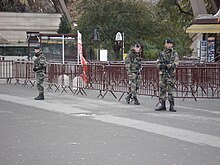Vigipirate plan
Plan Vigipirate is the term for French security measures to protect against terrorism . The name is an acronym of " french vigi lance " ( German vigilance ), and " French p rotection of the i nstallations contre les r Isques d ' a ttentats t erroriste à l' e Xplosif " ( German protection of bodies of terrorist against the risk of explosives ) . Since January 2015, a protection mission linked to the Vigipirate Plan has been assigned to soldiers under the name of Opération Sentinelle .
Alert levels since December 1, 2016
Since December 1, 2016, the new Vigipirate plan provides for a three-stage threat scenario.
The Vigipirate Plan provides for twelve areas of activity that could be affected by a terrorist threat and whose protection and mobilization in response to these threats are essential.
- Emergencies
- Gatherings
- Facilities and buildings
- Hazardous plants and hazardous substances
- Cybersecurity
- Air sector
- Maritime sector
- Transport routes
- Health sector
- Food supply
- electronic communication networks, water, electricity, energy supply
- Foreign assignment (French citizens or travelers residing in France, representatives of the French state, French civil servants, French companies, sea and air transport)
The Vigipirate plan is based on the analysis of terrorist risks, in which the threat assessment and the identification of vulnerabilities are combined. The threat analysis is carried out regularly or as needed by all intelligence services. Weak points are identified by departments in their respective areas of responsibility.
criticism
Opponents of the plan criticize the restriction of civil liberty and privacy and speak provocatively of a "Plan Vichypirate", alluding to the Vichy dictatorship of the 1940s.
history
The Vigipirate Plan was first launched in 1978 under President Valéry Giscard d'Estaing and updated in 1995, 2000 and 2003. Depending on the level of the plan defined by the government, security measures of different levels are implemented. Until February 2014, the levels “yellow”, “orange”, “red” and “ écarlate ” existed (scarlet red, meaning: deep red, meaning “acute threat”). Since July 7, 2005, the day of the terrorist attacks in London , the “red” level has been in effect without interruption. This was expressed, among other things, in the massive presence of security forces (including the military ), especially at train stations and in places with many tourists (e.g. at the Louvre or the Eiffel Tower in Paris ).
Alert levels (until 2014)
| Alert level | colour | meaning | measures taken |
|---|---|---|---|
| 0 | White | No danger | No danger |
| 1 | yellow | Unclear threat / increased vigilance | Raise security levels in order to counter real but as yet undefined dangers through local measures that only minimally disrupt normal activities, while the switch to "orange" or "red" is prepared within a few days. |
| 2 | orange | Possible threat / prevention of a terrorist act | Measures against credible risks of terrorist acts, including the use of resources that are moderately disruptive to normal public activities, while preparing the short-term switch to "red" or "scarlet" where possible. |
| 3 | red | High threat probability / prevention of a serious attack | Measures against a proven risk of one or more acts of terrorism, including measures to protect public institutions and the establishment of adequate means of rescue and response, as well as authorizing significant levels of disruption to social and economic activity. |
| 4th | scarlet | Clear danger / prevention of a major attack | Disclosure of a risk of major attacks which, simultaneously or otherwise, cause great devastation using non-conventional means; Appropriate means of rescue and reaction are prepared and measures that are very disruptive to public life are permitted. |
Alert levels from February 20, 2014
Since February 20, 2014, there have only been two levels of vigilance and alert attentat . Since January 7, 2015, due to an attack on the editorial staff of Charlie Hebdo magazine, the status alert attack has been in effect for the Île-de-France , and the French military has been ordered to support the greater Paris area. On January 8, 2015, the Alerte Attentat status was extended to the Picardy region to the north . Since February 4, 2015, the Alerte Attentat has also been in effect for the Alpes-Maritimes department ; all other regions of France were classified in the vigilance level . After Saint-Quentin-Fallavier attack on June 26, 2015. on the orders of President Francois Hollande for the region Rhône-Alpes the highest level Alerte assassination proclaimed that should apply initially for three days.
Web links
Individual evidence
- ^ Vigipirate: 3 niveaux d'alerte face à la menace terroriste , Service Public. Retrieved December 13, 2018.
- ^ Website of the French government on the Code d'alerte , accessed on March 2, 2015 (French)
- ↑ Un lycéen déguisé sème la panique à Nice , Le Figaro, (French) February 17, 2015. Accessed March 2, 2015.
- ^ Website of the Prefecture of the Département de l'Ain (web archive). Accessed December 13, 2018 (French)





